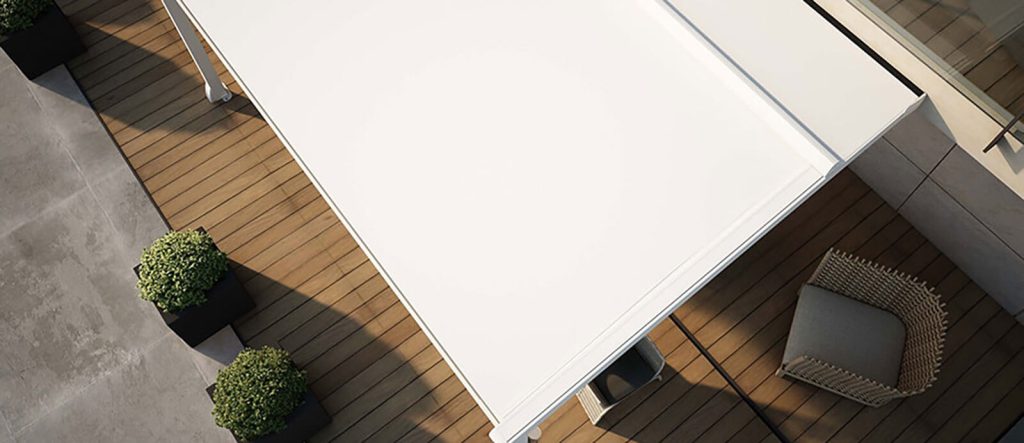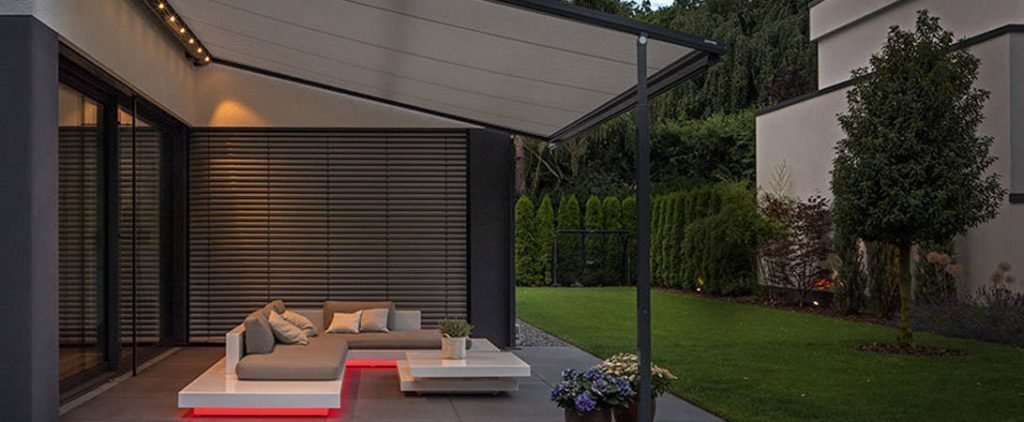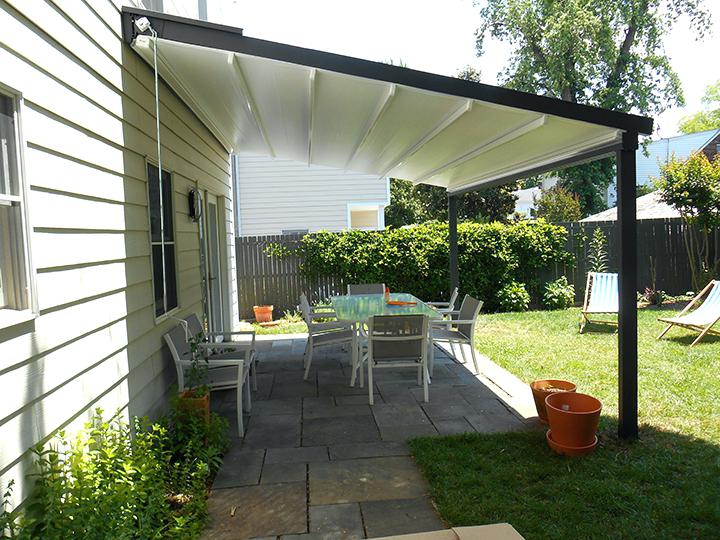If you’ve gone through the trouble of investing in a retractable awning, it’s important to also maintain it. You’ve spent your hard-earned money on it after all and it’d be a shame for it to waste away. Neglecting its upkeep will cause problems down the line, possibly costing you to fix any repairs. So with that in mind, knowing how to correctly care for your awning is necessary.
The easiest way to do this is by creating a regular routine. As with everything, consistent care and attention will ensure your awning remains effective and problem-free. This is especially true for retractable awnings as they have mechanisms that need to function smoothly.
On that note, let’s take a look at some tips on how to care for your retractable awning ( or any other). We’ll look at some common problems and how you can tackle them, so your awnings retain their excellence.
1. How to Clean Your Retractable Awning
There are a few different ways your awnings can soil. And there isn’t a whole lot you can do to prevent this entirely either, seeing as how they’re outdoor fixtures. However, what you can do is stay on top of the upkeep, so it doesn’t snowball into something bigger.
Some of the most common things include:
- Mould and mildew: This is easily the bane of any awning’s existence. It can develop quite quickly, especially in wet and humid weather, causing damage over time. For fabrics, mould and mildew can be detrimental. The best thing to do is firstly to avoid any harsh cleaning solutions. All you need to do is first brush it away. Then use cold water to rinse the awning, which should easily dislodge any dust and dirt. Allow to dry in full sun. Be sure to stay away from bleach at all costs. Not only will this be ineffective for the purpose, it can damage the fabric. If mildew has already set in, then a simple mildew remover will do the job. Just wet the awning thoroughly, then add the remover and scrub with a brush. Finally wash it all away, and let the awning dry out.
- Debris – Dry leaves/ branches, insects: Stay on top of debris like dry leaves and branches by sweeping them off every so often. Doing this will keep grime away. You needn’t take down the awning, simply make use of a ladder to reach. A broom will suffice, and be sure to clean both the top and underside of the awning. When sweeping, start from the bottom and work your way up. How often you do this depends on how susceptible your awning is to accumulating debris.
- Stains/ marks: The easiest way to prevent stains and marks from setting into your awning is to hose it down at least once a month. Your garden hose is good enough for this. Rinse both sides of the awning, and try do it on a sunny day so the awning can thoroughly dry out. Don’t use anything other than a hose, as anything with more pressure could damage the fabric. Any new stains can be spot-cleaned with soapy water. Try to tackle stains as soon as they become visible, as it can be tough to remove them once set in. Bird poop and tree sap can be especially difficult, so try get to them before they dry. If dry, again soap, water and a soft brush will do the trick.
2. Most Common Problems with Awnings
Aside from the above, your retractable awning is also vulnerable to a few other things. Some of them include:
- Sun damage: We all know and love the sun, but its harmful rays, not so much. Seeing as how your awning will detract sunlight from your home, it comes into contact with a lot of it. Over time, this can cause fading. However, today there are fade-resistant fabrics that are built specifically with this in mind. Choosing the right fabric really is half the battle when it comes to buying an awning. There are different types of awning materials to choose from for your needs.
- Electric sensors: With awnings like retractable awnings, motorisation is popular. It’s easy, convenient, and all in all a great solution. However, seeing as how the sensors are electrically operated, if there’s a power outage they may stop working. On rare occasions, they may also break down when continuously exposed to gruelling weather. No need to worry though, as this is an easy fix with the professionals.
- Motors: Without motors, your retractable awning won’t be much use. They help it move with the simple press of a button instead of a crank-handle. If the motor malfunctions, then so will the awning. This could be because of overheating, reaching its lifespan or a shorted wire. It’s easily fixable with the help of an expert.
3. How to Maintain Your Retractable Awning?
As mentioned at the beginning of this article, regular maintenance is key. Assess your awning as often as you can, so you can be aware of any issues early on. It’s a lot easier to nip something in the bud than trying to fix it later. Follow these care and maintenance instructions to keep your new outdoor awnings in good working order.
- Retractable awnings should be rolled up if high winds or storms are anticipated. Under no circumstances should water be allowed to pool on the awning.
- No other objects should be attached to, or hung from the awningsas damage may occur.
- The powder-Coated metal components and profiles of your awning should be cleaned twice annually or more regularly in coastal environments. Wash in tepid mild soapy water (preferably biodegradable) and rinse off. Build-up of dirt and salt on these surfaces reduces the life of the powder-coating.
- Lubricate moving components annually with light oil (SAE30 or similar) and apply sparingly. Avoid getting it on the fabric of the awning as it may stain.
- Roll-up only when clean and dry. If rolled up wet e.g. due to approaching storm, the awning should be extended and allowed to dry in the sun at the first opportunity.
- Never scrub the fabric of the awnings.
- Immediately remove deposits of organic matter (such as soil, grass cuttings, leaf litter, bird droppings, vehicle exhaust). Some leaf species can cause stains if wet; remove leaves before rolling up awning.
- Do not use soaps, detergents, solvents or other liquid cleansers on the fabric.
- Scotchguard brand Fabric Protector or approved wax based canvas treatments containing mildew inhibitors may be used in accordance with the manufacturers’ instructions.
- If your awning has a wind sensor, check at least twice a year to ensure the sensor paddle can rotate freely. Check it isn’t crowded with spider webs or vegetation etc. Keep in mind that electronic controls such as wind sensors are a valuable safeguard, but will not guarantee protection in all circumstances.
4. Why Should You Do It and How Often?
An awning is not simply an ‘add-on’, it’s an investment. And you want to take care of this investment like you would any other. Considering how retractable awnings are also more expensive than others, a premature breakdown would be quite painful. They help add value to your home, and can significantly help improve your lifestyle.
Conclusion
To sum up, as all things your retractable awnings must be maintained. It’s the best way to ensure longevity and effectiveness. Additionally, it’ll prevent the need to spend hours on your precious weekend scrubbing away bird poop. Use good old soap and water for tough stains, and rely on your trusty garden hose for the rest. Should bigger issues with the tech side of things arise, be sure to let us know so we can send in the experts. We recommend not taking issues with sensors and motors into your own hands.
Book an in-home consultation with one of our experts consultants to find out more in person. We’ll set you up with the right solution, for your peace of mind.










